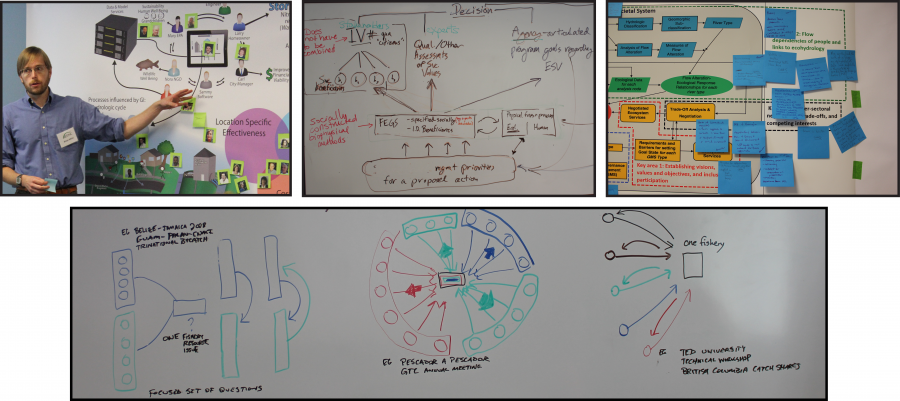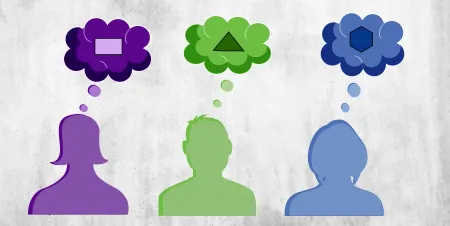socio-environmental problems they were researching.
A downloadable version of this explainer is available here:
Shared mental models are representations—usually visual ones. In the context of interdisciplinary research, they are meant to represent a research team’s joint understanding of something. For example, it could be their understanding of how something works or how they think about it. The mental model can represent a team’s understanding of the system being studied, including the core components and how they are related. (See the explainer What Is a Socio-Environmental System?). Or, it could be a representation of the research problem, the agreed-upon steps the team needs to take to address the problem, and/or the tools or data that are required for each step. The visualization, which may be abstract or very concrete, can be in the form of a drawing, list, schedule, flowchart, computer model, or diagram. Most often, it looks like a conceptual diagram (Figure 1) with boxes, arrows, and limited text. Shared mental models are also just one example of what is called a boundary object—something flexible enough that it can encompass a range of views/needs but robust enough to foster and sustain a sense of commonality (Star et al. 1989).
Models and Interdisciplinary Research
Building a shared mental model is a highly valuable activity for interdisciplinary research teams (Badham and Bammer 2017). Some view this activity as essential to the formation of a cohesive team that can communicate effectively and move forward with innovative, integrative research. The process of co-developing mental models is most valuable if begun at the onset of teamwork, i.e., when the team is first defining the research. That point is the time to ensure that everyone is able to express their viewpoints and, through discussion, for the team to negotiate agreement on the research goals, key questions, and approaches. For discipline-diverse teams, members typically come to the collaboration with specialized terminology, different epistemologies, and distinct methods that they are comfortable with (Palmer et al. 2016). Many of these proclivities are based on their tacit knowledge—that is, knowledge based on experience or learning while doing something. The learner is often not even aware that they hold this knowledge; yet, it influences the expectations and assumptions they bring to team meetings.
If they have chosen to join a research team, most members already have some mental model of their own although they may not have thought of it as such explicitly (Bammer 2022). As described in the next section, making these “individually owned” mental models available to the whole team is essential for moving forward as a team in a cohesive and productive manner. These individual mental models can reveal assumptions and underlying views early, enabling team leaders to reduce conflicts among team members throughout the research process. Airing these differences helps to build trust and makes it more likely that if conflict does arise, the group will face it and negotiate a solution. It also makes building a shared mental model much easier, which in turn helps expedite the process of identifying new data needs and methods as they emerge and can facilitate task management and responsibilities. A shared mental model can serve as a roadmap that the team can revise as new knowledge is gained.
Steps in Developing Shared Mental Models
The first step of developing a shared mental model is to uncover the individual, “internalized” mental models—the individual assumptions and views—through discussion and group activities. This process may take the form of an exercise in which individuals first spend time alone drawing or somehow visually expressing their understanding of the research problem or system and what type of data/information they believe needs integration to solve the problem or understand the system. Second, individuals explain their visual representation to the rest of the team with time for questions and discussion before moving on to the next team member—the discussions are where the real work occurs. The visual itself is just a tool to facilitate group dialogue. The final step is for the team to identify how to bring the conceptualizations together, sometimes negotiating what can be dropped, what is similar but just expressed differently, and what they still need to develop.
This drawing exercise is only one way to develop a shared mental model. Many other methods exist (Langan-Fox et al. 2000), including, for example, a team member or facilitator providing a series of written prompts that individual team members respond to on their own and then engaging the group in a discussion of the differences between members responses (e.g., as in the Toolbox Initiative; Cwik et al. 2022).
Additional Reading
- Jones, N. A., Ross, H., Lynam, T., Perez, P. & Leitch, A. (2011). Mental models: an interdisciplinary synthesis of theory and methods. Ecology and Society, 16(1): 46-46. http://www.ecologyandsociety.org/vol16/iss1/art46/
- Van den Bossche, P., Gijselaers, W., Segers, M. et al. (2011). Team learning: building shared mental models. Instructional Science, 39, 283-301. https://doi.org/10.1007/s11251-010-9128-3
- Gray, S., Gray, S., Cox, L., et al. (2013). Mental Modeler: A Fuzzy-logic Cognitive Mapping Modeling Tool for Adaptive Environmental Management. Proceedings of the 46th International Conference on Complex Systems. https://doi.org/10.1109/HICSS.2013.399

